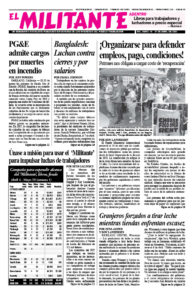The social crisis unfolding today — marked by mass layoffs, attacks on working conditions and skirmishes with the bosses — is hitting hardest on working people. The propertied rulers seek to salvage, off our backs, their profits system and their ability to compete with rivals abroad. And infections and deaths from the coronavirus disease also hit the working class hardest.
Especially impacted have been workers who are immigrants — Latinos, Africans, Asians and others — because of the pressures created by the rulers’ use of the fact that many don’t have papers to impose the lowest wages and worst jobs on them.
Amid lockdowns and soaring forced unemployment, and the bosses’ fear of workers’ response, laws and regulations are being put in place that target the political and constitutional rights of workers.
Asian workers have faced taunts and attacks whipped up by racist groups who say the Chinese are responsible for coronavirus.
With less access to quality health care and forced by low wages to live in small apartments holding several generations or numerous roommates, immigrant workers have been dying from COVID-19 at a much higher rate compared to their proportion of the population, especially in New York City.
Some of the hardest hit are in the working-class neighborhoods of Elmhurst and Corona in Queens. This is largely an immigrant area, with workers from some 200 nationalities and over 100 different languages. They work as Uber drivers, home health aides, and delivery people, and in restaurants, hotels and construction.
The New York Taxi Workers Alliance, whose members drive taxis and for-hire cars, says it knows of at least 28 drivers who have died.
Undocumented workers have been excluded from all government aid — in the past and with new government programs.
One 39-year-old construction worker originally from Ecuador, who gave his name as Ángel, told the New York Times, “I don’t have anyone to help me.” He said people like him have been left to fend for themselves.
Ángel had gone to Elmhurst Hospital — which was 80% full before coronavirus hit and is now completely overwhelmed with people seeking care. He was turned away because he didn’t display any “life-threatening” symptoms and sent home to the apartment he shares with three other workers.
Many are getting by only because of working-class solidarity. In the nearby Jackson Heights neighborhood, a group of Pakistani drivers organized to deliver meals to people who were sick. And a group of Nepalis are distributing protective gear to workers.
“We demand all those in the U.S. without papers be granted amnesty, a move that would strengthen the unity and fighting power of the entire working class,” Seth Galinsky, Socialist Workers Party candidate for U.S. Congress in New York’s 10th District, told the Militant. “We demand the government provide immediate jobless benefits for all workers, farmers and other exploited producers — whether or not they have ‘papers’ — for as long as they need it!”
Deaths in Latino, Black communities
In New York City, two-thirds of the over 5,200 people who died as of April 8 were Latinos or Blacks. When New York Gov. Andrew Cuomo was given these statistics, his response was to say he would launch a study to investigate this racial disparity.
But the answer isn’t a secret.
For years the death rate for Blacks and Latinos — those with papers and without — has been higher than for Caucasians. African Americans die disproportionately from “heart diseases, stroke, cancer, asthma, influenza and pneumonia, diabetes, HIV/AIDS, and homicide,” according to a 2017 U.S. Health and Human Services report.
In Chicago, part of Mayor Lori Lightfoot’s response to the growing social crisis is “to increase policing and traffic stops in Black neighborhoods,” Jawanza Malone, executive director of Kenwood-Oakland Community Organizations, told the Chicago Sun-Times. At the same time, health care in working-class areas that the bosses don’t consider profitable is being cut back. “We have four hospitals in [Chicago’s] Black community planned for closure,” Malone said.
The same thing is true in other working-class areas, in New York, other cities, Native American reservations and in rural areas across the country.

